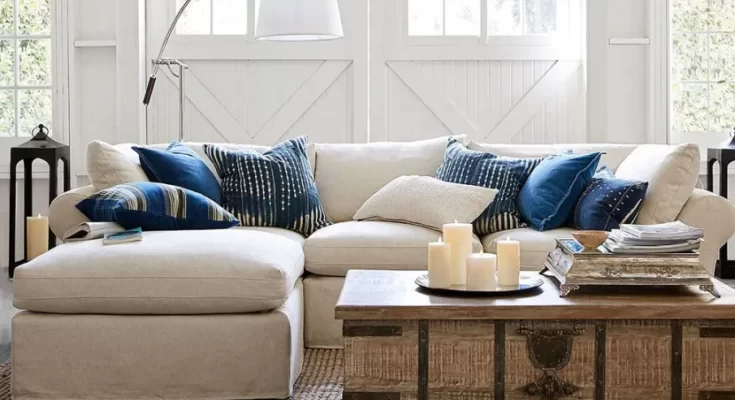There are many different types of indoor fabrics. These fabrics can be made of virtually any type of textile. They are commonly used inside and outside the home and are also water-repellent and easy to clean. Listed below are 5 Things to Know About Indoor Fabrics
Fabrics are made from almost any textile
You can create a stunning interior using indoor fabrics. There are many options for indoor fabric, and they can range in size from 40” to 130” wide. Depending on how you manufacture it, indoor fabrics can be made from cotton, polyester, silk, and even fine wool. They can be dyed or screen-printed to have any appearance you desire. And, because they are used indoors, indoor fabrics should be durable and fade resistant.
The basic raw material of textiles is fibers. The fibers are classified as natural or synthetic. They are further processed, usually by finishing, to give them special properties. Linen, for example, is a fabric made from flax, and is widely used for drapes, tablecloths, and upholstery. Decorative foil can be added to the fibers to give them color and brilliance. Wool and silk fabrics can be woven into nets.
They can be used indoors or outdoors
There are several benefits of indoor fabrics. Many fabrics are resistant to stains and liquids. They are also easy to clean and maintain. In addition to being durable, they are also UV resistant. In addition, some fabrics are suitable for both indoor and outdoor use. Here are a few of them. Read on to learn how they can benefit you. Indoor fabrics can be used in both indoor and outdoor environments. But which one is better?
One major difference between indoor and outdoor fabrics is the UV rating. While indoor fabric has a lower UV rating, outdoor fabric requires extra protection. Outdoor fabrics are typically made of synthetic fibers. The lower UV ratings of polyester make it a good choice for one-season use. Polyester will have the lowest UV test results, while acrylic and polypropylene will have a higher UV rating. However, it’s important to remember that indoor fabrics can also be used outdoors.
They are water-repellent
The most basic definition of water-repellent fabric is one that rejects liquids. Water-repellent fabric does this by rejecting moisture and water droplets. The water ‘beads’ and runs off the fabric as small particles that are easily wiped away. Water repellent fabrics are usually higher in thread count and have tighter weaves to resist water. But if you are looking for the highest level of water-resistance, you can choose a waterproof fabric.
Another type of indoor fabric is water-repellent. These fabrics resist liquids because they have little to no pores. This makes them perfect for upholstery in a wet environment. The best part is that water-repellent fabric does not absorb cleaning products. So if you have to clean the upholstery during a rainy season, you can rest assured that you won’t have to use harsh cleaning agents.
They are easy to clean
Today’s indoor fabrics are stain-resistant and easy to clean. If you have children or pets, then you’ll want to choose these fabrics. They are also highly resistant to everyday household stains, and they come in a range of colours to suit both minimalist and maximalist interior designs. Choosing easy-to-clean fabrics for your furniture and decor is an excellent way to make your home look great and last a long time.
If your furniture gets dirty, you’ll want to do your best to clean it as soon as possible. You can blot spills with a microfiber cloth or use baby wipes. You can also clean stains and odors with baking soda or club soda. After cleaning, make sure to air dry the piece before storing it. Then, wipe it down with a damp cloth. If you don’t want to use a cleaning agent, you can also place baking soda on your furniture.
They are stain-resistant
When selecting fabric for indoor furniture, a few things should be considered: ease of cleaning, durability, and amount of hands-on contact. Fabrics should come with a label indicating stain resistance and stain release. If the label is missing, a look at the wash instructions will give you some hints. Although all fabrics should be cleaned regularly, choosing a fabric that repels stains can make your life easier.
Crypton Super Fabric is one type of fabric that resists stains. Its unique technology provides stain and liquid resistance. This fabric’s back-to-front weave helps it repel stains and microbes. The special liquid formula applied during production works to fight stains. Even soapy water residue will not penetrate Crypton Super Fabric, making it an ideal choice for indoor furniture. Its durability will help it last for years, and you’ll be proud to show off the stain-resistant indoor fabrics you bought for your home.
They are odor-resistant
While synthetic fabrics have a higher odor-resistance than natural fabrics, they are not as effective at preventing body odor. Polyester, for example, is a quick-drying fabric that tends to intensify body odor. Natural fabrics, on the other hand, tend to be more odor-resistant and don’t hold moisture. Depending on the type of fabric you have, you may be able to use an alternative shirt or two while the first shirt is being washed.
Nylon and polyester are two synthetic fabrics that have inherent odor-resistance properties. Nylon resists most chemicals and is extremely durable. Both are easy to clean and resistant to stains. However, they do not resist water and mildew. Polyester can be smooth and textured. Although it resists most chemicals, bacteria can grow on it, resulting in an odor. Therefore, you should use natural fabrics in your home if you want to avoid odor-causing fabrics.




